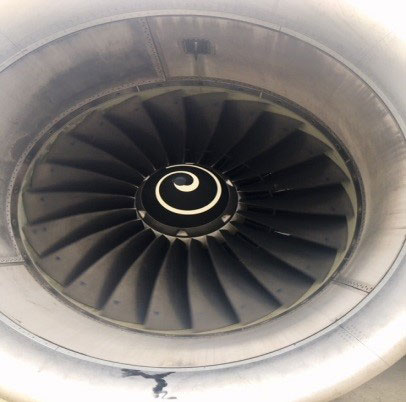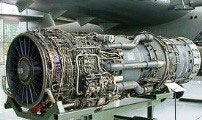
To better suppress an aircraft engine fire, the aircraft rescue firefighter must have a thorough understanding of the anatomy of an engine. The reason for this need is because with the limited amount of extinguishing agent carried on ARFF vehicles, it is imperative that when we commit to an incident that our agent of choice be the correct one to lessen damage to the aircraft components and provide a greater level of safety for the passengers, flight crew, and firefighters.
Now, in the scope of commercial aviation, aircraft engine fires are very rare with today’s technology being so advanced that many incidents have been prevented literally through preengineering. The media hype for an incident involving an engine fire making headline news is a strong indicator of just how infrequent these types of incidents really are. That said and seeing that they rarely occur, ARFF industry professionals must be prepared to handle these incidents because of the lack of exposure. For the sake of site-specific training today, we will be talking about jet engine fires that are fueled by kerosene blended Jet-A fuels. A jet engine is a type of reaction engine discharging a fast-moving jet that generates thrust by jet propulsion. This broad definition includes air-breathing jet engines like the turbojet, turbofan, ramjet, and pulse jet engine designs.
Three Typical Types of Aircraft Engine Fires
Internal Nacelle Fire: Fires involving internal components located inside the nacelle require agent application directly to the source. Many times, we see ARFF vehicle turrets spraying agent wildly, and much of the agent is wasted on areas that are not on fire. In the following pictures, you can see that what is behind the fan blade matters! On the picture on the bottom, you can see the inner ring behind the primary fan blades in the center that channels the incoming air into the nacelle and compressor.


Air passes straight through the outer portion of the engine intake (the bypass exhaust) and does not go into the nacelle or core. The leading causes of a fire inside of the nacelle core are component failures and excessive fuel. The agent of choice for an internal nacelle fire is clean-agent Halon. The aircraft’s onboard fire suppression system supplies a limited amount of Halon at the direction of the pilot or copilot.

External Nacelle Fire: Fires involving the external components of an aircraft engine are often related to plumbing, fittings, piping components ,and the fluids that run in these lines. These engines spin fan blades at some incredibly high revolutions per minute, and any excess vibration can cause loose or even broken fittings with the fuel and hydraulic lines leaking. Excess oil, over pressurization of oil, and/or fuel spillage can then autoignite when the liquid contacts extremely hot aircraft components. Fires external to the nacelle but still within the aircraft engine are easy to identify because the smoke or flames are more readily present from the aircraft engine’s shroud (covers) and any access ports. There are typically no flames coming from the intake or the tail cone of the engine’s nacelle. In the picture below, we want to show you the number of lines hidden by the cosmetic shroud or covers.

Uncontained Catastrophic Failure of Moving Parts: In recent news, many people have seen raw video footage of an uncontained engine disintegration when a woman seated inside the plane died after debris from the engine penetrated the passenger window located near her. These types of incidents are very rare, but they are classified as uncontained because internal components of the engine exited the engine assembly and caused damage to other parts of the aircraft. This type of violent damage typically causes an engine fire when the fuel and other hydraulic lines are damaged, causing the fuel or hydraulic oil to come in contact with hot engine parts. Identifying this type of engine fire on arrival is often easy because the engine shroud and fan blades may be either missing or obviously deformed from the violent trauma. The other sure-fire size-up characteristic I have used is the presence of fluids on the ground underneath the engine that is on fire as depicted in my photo below.

The pilots and crew are trained to mitigate engine fires. The emergency checklist of operating instructions in the cockpit is pretty straight forward for all airlines. Engines are also equipped with fire suppression and containment systems, so pilots are trained to idle down the engine; shut off the fuel supply to the engine that is on fire, which will cut all engine thrust to the affected engine; and activate the fire suppression system. The crew will then seek to land the plane as quickly as possible, making an emergency landing at the nearest and most applicable airport to assess damage. According to a Civil Aviation Authority (CAA) study of all fatal plane accidents between during a nine-year period (2002 to 2011), engine fires were a “primary” factor in only two of 250 aircraft crashes. An aircraft is not even considered to have suffered a “substantial amount of damage” required for accident reporting if the fire-related damage is limited to the engine itself. But if said damage gets beyond the engine assembly, perhaps affecting the engine mount, the wing, or the fuselage, then there is a definite potential for greater impact of other aircraft systems or components. The greatest concern listed would be damage to the wing. As we all know, the wing is wet and contains large amounts of fuel storage for flight. When damaged, the engine fire might catch some of the fuel from a high heat exposure or shrapnel from internal component explosion. When this occurs, we will have a three dimensional (3D) running fuel fire that will dramatically change the severity of the fire and difficulty in rapidly extinguishing it.
Last, the engine fire could damage some of the mechanical components of nearby systems. These include, but are not limited to, the components needed to maintain control and fly the aircraft like flaps, hydraulic systems, landing gear, etc.
ARFF Tactics
The basic fundamentals for ARFF response still stand. Aircraft location, terrain, topography, up-wind, and up-hill are all important factors to take into consideration prior to arrival and vehicle set up. The determination of an engine fire is quite obvious. You have an engine that is either smoking or on fire. The choices you make after that identification require a strong understanding of the systems and components that might be involved. Proper selection of extinguishing agent is critical. Smaller, internally contained engine fires can afford the fire suppression team an opportunity to cleanly extinguish the blaze with a clean agent application. Warning: Choosing a dry chemical extinguishing agent from the start on a small internally contained engine fire may cause greater damage to other systems and components from the corrosive nature of the chemical. But if the engine fire has grown beyond internal containment and you now have more hazardous exposures, then the agent of choice would be mass application of water and AFFF directly on the source of the fire. The best tool in the toolbox is the well-educated firefighter. I suggest you get out and visit your FBO (fixed-base operator) and ask questions of the aviation mechanics regarding aircraft engine, design, and features. Stay safe, my friends.
WILLIAM GREENWOOD is a 25-year veteran of the fire service. He is currently the Assistant Fire Chief of Training at the Manchester-Boston Regional Airport. He is a Senior Staff Instructor for the New Hampshire Fire Academy and owns FETC Services, which provides advanced firefighter and leadership training/consultation services. He is also a national speaker for FDIC International and has been published in Fire Engineering and FireRescue.

